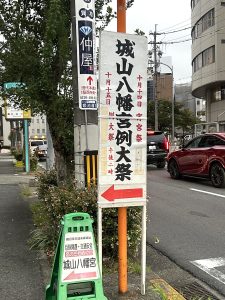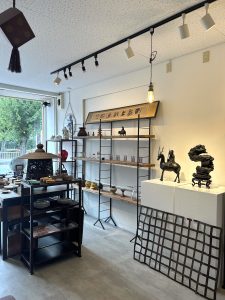城山八幡宮で七五三参りのご家族を見かけるようになりました(愛知県名古屋市千種区姫池通 骨董買取 古美術風光舎)
2025.10.15
ご近所の城山八幡宮への坂道をのぼっていく車がいつもより多いなと思っていましたら、本日14時から例大祭が行われるとのこと。おそらく数日前から設置されていたであろうこちらの看板も目に入っていたはずですが、頭の中を素通りしていたようです。昨日は宵宮祭だったのですね。自分がいかにぼんやり歩いているかがよく分かります。

現在、城山八幡宮では七五三参りも行われているため子連れのご家族もいらっしゃいました。もうそんな時期なのかと1年が過ぎる速さに愕然とします。
先日、甥と姪の子ども(いずれも男の子)の3歳の七五三の写真を見せてもらったのですが、今は男の子も3歳と5歳のお祝いをすることが多いようですね。以前は男児は5歳のみの祝いが多かった気がするのですが地域による違いもあるのでしょうか?
それにしましても、ついこの間までハイハイしていた赤ちゃんが袴を着て凛とした顔でポーズをとっているのですから子供の成長は恐るべしです。
七五三の起源には諸説あるようですが、江戸幕府5代将軍の徳川綱吉が天和元年11月15日に長男の徳川徳松の健康を祈ったことが有力な説とされています。元は関東圏のみで行われていましたが、やがて大阪や京都に広まり、その後全国で行われるようになりました。
旧暦では15日というのは鬼が家にこもり出歩かない日とされる二十八宿の鬼祝日にあたるそうで、婚礼行事以外は何事も上手くいく開運日とされています。鬼という言葉がつくので誤解してしまいそうですが、そんな開運日があったのですね。今年はあと11月7日と12月5日だそうです。
七五三は子供がここまで成長できたことへの感謝と今後の健やかな成長を神様に祈願する儀式です。七五三の年齢は子どもの成長の節目の時期に行われた3つの行事に由来します
。
平安時代には3歳までは男児も女児も髪の毛を剃髪(丸坊主に)する習慣がありました。頭を清潔に保つと同時に健康な髪の毛が生えてくると信じられていたからです。そして3歳の春に「髪置きの儀」を行いました。長寿を願い白髪の代わりに白い糸などを子供の頭にのせて祝い、その後髪を伸ばし始めました。
男の子のお祝いが5歳とされるのは「袴着の儀」に由来します。平安時代5歳から7歳の男の子が正装の袴を初めて着用する儀式でした。当時は袴を左足からはかせ、「四方を制する」という願いを込めて碁盤の上に立たせていたのだとか。
7歳になると女の子は付け紐のついた子供用の着物から本式の着物を着用します。これを「紐解き・帯解き」といい、一人で帯を結び大人の仲間入りをする大切な節目とされていました。今と違い当時は子供が無事に育つことは難しく、7歳までは魂が身体に定着していないとされ、「7歳までは神のうち」という言葉もあったほどです。7歳まで無事に育ったという感謝の思いは現代の私たちの想像以上に大きなものだったのかもしれませんね。
しばらくは城山八幡宮を訪れる七五三参りの子どもたちに癒されたいと思います。
それでは、また次の機会に。(スタッフH)

I noticed more cars than usual climbing the slope to the nearby Shiroyama Hachimangu Shrine, and then learned the annual festival begins today at 2 PM. I must have seen this sign, likely put up several days ago, but it must have slipped my mind. So yesterday was the eve festival. It really shows how absent-mindedly I walk around.
Currently, Shiroyama Hachimangu is also holding Shichi-Go-San ceremonies, so families with children were visiting. It’s already that time of year? I’m stunned by how quickly the year has passed.
The other day, I saw photos of my nephew and niece’s sons celebrating their third Shichi-Go-San. It seems common now for boys to celebrate at both ages 3 and 5. I recall it being more common for boys to celebrate only at age 5 before. Is this a regional difference?
Even so, it’s astonishing how quickly children grow. Just the other day, they were crawling around, and now they’re posing in hakama with such dignified expressions.
There are various theories about the origins of Shichi-Go-San, but the most widely accepted one is that it began when Tokugawa Tsunayoshi, the fifth shogun of the Edo shogunate, prayed for the health of his eldest son, Tokugawa Tokumatsu, on November 15th of the first year of the Tenna era. Originally practiced only in the Kanto region, it gradually spread to Osaka and Kyoto, and later became a nationwide custom.
In the old lunar calendar, the 15th day is said to coincide with the “Oni-shukujitsu” (Demon Celebration Day) of the twenty-eight lunar mansions, a day when demons are said to stay indoors and not roam. It is considered a lucky day when everything goes well, except for wedding ceremonies. The word “oni” (demon) might be misleading, but such a day existed. This year, the other days are November 7th and December 5th.
Shichi-Go-San is a ceremony to express gratitude to the gods for the child’s growth thus far and to pray for their continued healthy development. The ages for Shichi-Go-San are tied to three ceremonies held at key milestones in a child’s growth.
During the Heian period, both boys and girls had their heads shaved bald (marubōzu) until age three. This was done to keep the head clean and was believed to encourage healthy hair growth. Then, in the spring of their third year, the “Hair-Setting Ceremony” (Kamioki-gi) was performed. Wishing for longevity, white thread or similar items were placed on the child’s head in place of white hair to celebrate, and from then on, the hair was allowed to grow.
The celebration for boys at age five originates from the “Hakamagi Ceremony.” This was the ritual where boys aged five to seven first wore formal hakama trousers. At that time, the hakama was put on starting with the left leg, and the child was made to stand on a go board, symbolizing the wish to “control the four directions.”
At age seven, girls transitioned from wearing children’s kimono with attached strings to wearing full-fledged adult kimono. This was called “Himekaki/Obi-kaki” (literally, “untying the strings/untying the sash”) and was considered an important milestone where they tied their own obi sash, marking their entry into adulthood. Unlike today, raising children safely was difficult, and it was believed their souls hadn’t fully settled into their bodies until age seven. There was even a saying, “Until seven, they are still gods.” The gratitude for a child surviving safely until age seven was likely far greater than we can imagine today.
Until next time. (Staff H)
*******************
ご実家の整理やお片付けなどをされている方のご相談などが多くございます。
お片付けなどくれぐれもご無理のないようになさってくださいませ。
風光舎では古美術品や骨董品の他にも絵画や宝石、趣味のお品など様々なジャンルのものを買受しております。
お片付けをされていて、こういうものでもいいのかしらと迷われているものでも、どうぞお気軽にご相談下さいませ。
また風光舎は、出張買取も強化しております。ご近所はもちろん、愛知県内、岐阜県、三重県その他の県へも出張いたします。
なお、毎月21日の持込鑑定会では無料鑑定・買取・ご相談など、ご予約なしで承っております。
ご近所の皆さま、ご遠方のみなさまも、お気軽にお越しくださいませ。
まずは、お電話お待ちしております。
愛知県名古屋市千種区姫池通
骨董 買取【古美術 風光舎 名古屋店】
TEL052(734)8444
10:00-18:00 OPEN
#出張買取#骨董#古美術#骨董品#絵画#版画#茶道具#刀剣#彫刻

